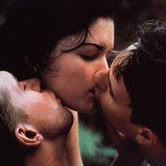Do you
strongly believe that you are physically or romantically attracted by male only
or by female only? Have you ever realized that you may show affection to both
genders? Maybe your answers are absolutely “no”; maybe you are frightened by
your answers. But no matter what your answers are, the two questions inevitably
bring us to the topic – bisexuality. My motivation of dong this speech is not
curiosity, but my respect for the honesty and openness I find in the bisexual community. In order to make more of you have a correct understanding of this
community, I am going to introduce information about bisexuality to you. My
speech covers a general description of bisexuality, factors leading to bisexual
orientation, its prevalence and the social status of bisexual community.
The American
Psychological Association states that sexual orientation is described into
three patterns – homosexual, bisexual and heterosexual. Basically, bisexuality
is sexual behavior or an orientation, involving physical and romantic
attraction, to both males and females. Bisexual people recognize that they are
open to potential for intimate, affectionate or sexual relationship with
persons of any gender. Despite misconceptions, bisexuality does not require
that a person be attracted equally to both genders. In fact, people who have a
distinct but not exclusive preference for one sex over the other may still identity themselves as bisexual.
There is
no general agreement among scientists about the exact reasons that an
individual develops a bisexual orientation. But Sigmund Freud theorized that
every person has the ability to become bisexual at some time in his/her life.
Marjorie Garber, Harvard Shakespeare professor, also argued that “most people
would be bisexual if not for repression, religion, social denial and pressure.
So generally speaking, reasons leading to bisexual orientation include a
combination of genetic, hormonal factors and social environment factors.
Further researches indicate that bisexuality is influenced by biological,
cognitive and cultural variables in interaction, and these factors lead to
different types of bisexuality.
Nowadays
bisexual community is continuously enlarging. A 2002 survey conducted by the US
National Center for Health Statistics found that 1.8 percent of men aging 18 to
44 considered themselves bisexual, and 2.8 percent of women aging 18 to 44
considered themselves bisexual. These two ratios are both larger than those of
homosexuals.
Although
bisexuality claims its existence in our society, many bisexuals feel they seem
to be invisible in public. Due to cultural misconceptions and social pressure,
some of them tend to hide their actual sexual orientation. Actually this may
affect bisexuals’ mental health. As Freud maintained that bisexuality is a
normal part of development, and all of us experience a period of bisexuality
and most of us remain on some unconscious level; so bisexuality is not
something should be penalized or criticized, and more recognition of bisexual
identity is expected in our society.
So much
on bisexuality in human society, and I know people always like stories in
animal world; so I would like to end my speech with animal story. The
interesting thing is that many animal species also show bisexual behaviors.
Examples include mammals, bottom nosed dolphins, fish and flatworms. In some
cases, animals will choose to intercourse with different sexes at different
time, and sometime they will perform intercourse with different sexes at
random. It seems that bisexuality is part of nature’s creation.


Comments
Post a Comment